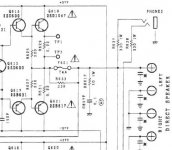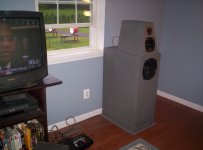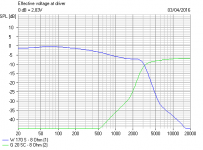Examples:

Case 1:Voltage source, Rs =0. Z increases, V is constant, I2 goes down.
Case 2:Current source, Rs finite. Z increases, Thus Z in parallel with Z*, (Z||Z*) increases. As a result of (Z||Z*) in series with Rs, V increase, Since V increases, Vs must increase to keep Is constant. But since V increased and Z* remains constant, I1 increases. Since I2 = Is - I1, I2 must decrease. So, voltage across the speaker increase but current decreases. That is, while the voltage across the speaker increases it does not increase sufficiently to counter the increase in Z, hence the current through the speaker decreases.
Hi John,
I'm not getting why you say I2 must decrease in the example circuit. I understand that the total amperage is divided between the two parallel paths, so I2 = Is - I1 makes perfect sense. But I would expect the current through Z* and Z to be independent of each other.
Why is it not as simple as I1 = V/Z* and I2 = V/Z?
Thanks,
Chris
I think what he is saying is that with current drive, the total current is constant. So if the Vc imp rises, the current division shifts to less current into the Vc and more into Z*.
Jan
Jan
I think what he is saying is that with current drive, the total current is constant. So if the Vc imp rises, the current division shifts to less current into the Vc and more into Z*.
Jan
Yes, what I was trying to get across is that first, because Z increases, V must rise. The current would be I2 = V/Z but that doesn't tell you which goes up faster, V or Z; it doesn't tell you if the current, I2, increases or decreases. But since Z* remains constant, I1 = V/Z* and since V is greater, I1 must be greater, thus I2 must be less even though V is greater. It tells you that Z increased a greater percentage than V did.
... which in turns means that because of the Z* (flattening) you lose part of the advantage of current drive - hey, even the name gives it away ;-)
Now if there was an advantage to offset this disadvantage we could deliberate what would be the best compromise. But I don't see any advantage at all.
With voltage drive, it just asks more from the amp without giving anything extra to the speaker, and with current drive it partially negates the advantage you were looking for, without giving anything in return.
So wtf is it that makes this flattening stuff worth anything??
Jan
Now if there was an advantage to offset this disadvantage we could deliberate what would be the best compromise. But I don't see any advantage at all.
With voltage drive, it just asks more from the amp without giving anything extra to the speaker, and with current drive it partially negates the advantage you were looking for, without giving anything in return.
So wtf is it that makes this flattening stuff worth anything??
Jan
Let's move back on-topic. I think current and voltage drive get to the same place. This is just Norton-Thevenin equivalents as attached.
Series filters and parallel filters can also get to the same place with varying levels of elegance. Edward Norton did constant resistance networks back in 1928:
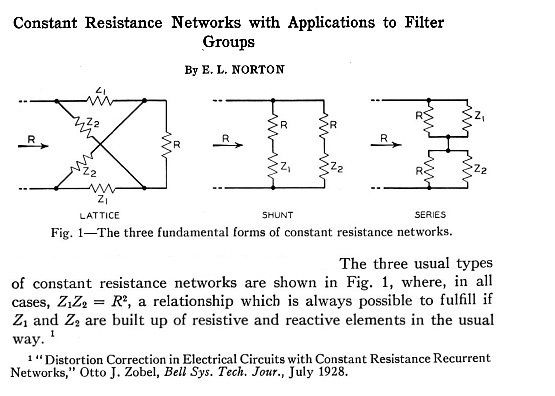

I think you either believe Class AB amplifiers are affected by load or you don't. IMO, you're essentially hearing bipolar transistor crossover distortion more with a speaker that is not constant impedance. The output stage can't produce high current changes fast enough at the zero volts crossover because the output transistors can't switch on and off instantly.
So I don't think Joe Rasmussen is dreaming here. 😎
Series filters and parallel filters can also get to the same place with varying levels of elegance. Edward Norton did constant resistance networks back in 1928:


I think you either believe Class AB amplifiers are affected by load or you don't. IMO, you're essentially hearing bipolar transistor crossover distortion more with a speaker that is not constant impedance. The output stage can't produce high current changes fast enough at the zero volts crossover because the output transistors can't switch on and off instantly.
So I don't think Joe Rasmussen is dreaming here. 😎
Attachments
IMO, you're essentially hearing bipolar transistor crossover distortion more with a speaker that is not constant impedance.
Is there any data to support that? It doesn't seem to make sense.
I think what he is saying is that with current drive, the total current is constant. So if the Vc imp rises, the current division shifts to less current into the Vc and more into Z*.
Jan
Yes, what I was trying to get across is that first, because Z increases, V must rise. The current would be I2 = V/Z but that doesn't tell you which goes up faster, V or Z; it doesn't tell you if the current, I2, increases or decreases. But since Z* remains constant, I1 = V/Z* and since V is greater, I1 must be greater, thus I2 must be less even though V is greater. It tells you that Z increased a greater percentage than V did.
I think I'm with you guys now. Does a current amp basically just track the voltage drop across Rs and adjust gain to keep it constant?
So, doesn't flattening the overall circuit impedance with a parallel path kind of cripple the ability of a current amp to adjust for the impedance of the actual driver at different frequencies? With that kind of parallel path the amp can no longer "see" the real current through the actual driver and adjust for it.
Am I still missing something big here?
If I say I prefer the sound of a flattened impedance, when using a current amp, am I not saying that I prefer the sound of the amperage through the actual driver not being as constant?
-Chris
... which in turns means that because of the Z* (flattening) you lose part of the advantage of current drive - hey, even the name gives it away ;-)
Now if there was an advantage to offset this disadvantage we could deliberate what would be the best compromise. But I don't see any advantage at all.
With voltage drive, it just asks more from the amp without giving anything extra to the speaker, and with current drive it partially negates the advantage you were looking for, without giving anything in return.
So wtf is it that makes this flattening stuff worth anything??
Jan
This is my thinking too. But surely it isn't so simple.
-Chris
Steve with all due respect, I think you ended up in the wrong thread. This one is about speakers, crossover filters, Thiel-Small etc.
If you want to talk amplifier crossover distortion, there's a couple of threads in the ss forum you could help out.
Jan
If you want to talk amplifier crossover distortion, there's a couple of threads in the ss forum you could help out.
Jan
... which in turns means that because of the Z* (flattening) you lose part of the advantage of current drive - hey, even the name gives it away ;-)
Exactly and the point was making a long tome ago. The so called advantages of current drive only apply when a driver is directly connected to an current source. As soon as there is anything in parallel with the driver, changes in the driver's Z affect both the current through and the voltage across the driver. It's just a matter degree.
I think I'm with you guys now. Does a current amp basically just track the voltage drop across Rs and adjust gain to keep it constant?
So, doesn't flattening the overall circuit impedance with a parallel path kind of cripple the ability of a current amp to adjust for the impedance of the actual driver at different frequencies? With that kind of parallel path the amp can no longer "see" the real current through the actual driver and adjust for it.
Am I still missing something big here?
If I say I prefer the sound of a flattened impedance, when using a current amp, am I not saying that I prefer the sound of the amperage through the actual driver not being as constant?
-Chris
Ideally, Z and Z* such that Z||Z* = RcR. By RcR mean I mean real, constant resistance. Constant in time and frequency. So, Rs in series with Z||Z* makes the current source act like a voltage source. V across the speaker is constant and I through the speaker is V/Z. In other words you make the speaker response as if it were directly connected to a voltage source. Just a lot more inefficient. So, yes, basically you last sentence is correct.
Ideally, Z and Z* such that Z||Z* = RcR. By RcR mean I mean real, constant resistance. Constant in time and frequency. So, Rs in series with Z||Z* makes the current source act like a voltage source. V across the speaker is constant and I through the speaker is V/Z. In other words you make the speaker response as if it were directly connected to a voltage source. Just a lot more inefficient. So, yes, basically you last sentence is correct.
Ok, cool. Thank you for the help.
-Chris
Jan, and SY, this thread going nowhere fast unless you approach it right. It's getting very bogged down by people's lack of understanding of imperfect amplifiers. Because Thiel-Small has very little to do with what Joe is talking about IMO.Steve with all due respect, I think you ended up in the wrong thread. This one is about speakers, crossover filters, Thiel-Small etc.
If you want to talk amplifier crossover distortion, there's a couple of threads in the ss forum you could help out.
Jan
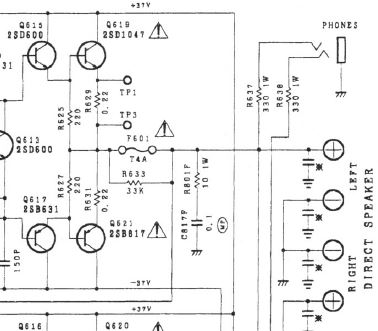
That is a real world voltage amplifier. A Rotel RA-931. I don't make this up. OK? Believe me, they have limitations and compromises just like speakers.
Now John Kreskovsky is questioning whether a rather good series crossover speaker impedance that goes high in the bass is easier than a flat one for the amp.
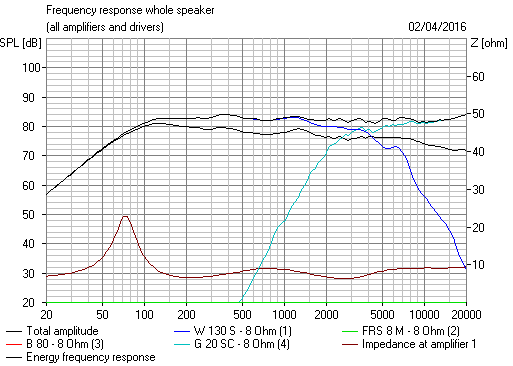
I'm not sure I care, because Class AB amps have lots of open loop gain at low frequency, so probably work largely as advertised. And we're not overloading them either.
Now, because I like this topic, let's look at Joe's filter again:

Driven by a "Perfect" voltage amp, which presents a short circuit output impedance to the speaker, the speaker cannot even "see" the correction network. All it sees is a short.
It's the Amp that sees the correction network. And it works better. Geddit? 😎
No, I don't "geddit." This doesn't answer John's points at all. The amp has to supply extra power to the passive networks which adds nothing to the acoustic output. "Crossover distortion" doesn't enter into any of that.
SY, we've had our fallouts in the past, but actually, I quite like you these days. And TBH, I shared your doubts about cable-lifters, unless the amp was wobbling on instability as Naim Amps often do. 😀
TBH, Joe has given us the output of his labours absolutely for free. Just to prove how generous with ideas I too can be, here's a World First! The Bud Fried series crossover. Never before published. I think it must be out of copyright now. 😎
What amazed me about this famous design, which some people said was the best speaker ever, was the flat impedance. Sure transmission line too. 🙂
I, like you, am actually still learning new stuff about speakers. And TBH, I'm no fool about amplifiers. I used to build them, even hot-running transconductance types, before I realised it was not a productive use of my time.
I'm not sure correcting the bass impedance is important, but the rest of Joe's ideas, like the tweeter Fs notch, I like.
TBH, Joe has given us the output of his labours absolutely for free. Just to prove how generous with ideas I too can be, here's a World First! The Bud Fried series crossover. Never before published. I think it must be out of copyright now. 😎
What amazed me about this famous design, which some people said was the best speaker ever, was the flat impedance. Sure transmission line too. 🙂
I, like you, am actually still learning new stuff about speakers. And TBH, I'm no fool about amplifiers. I used to build them, even hot-running transconductance types, before I realised it was not a productive use of my time.
I'm not sure correcting the bass impedance is important, but the rest of Joe's ideas, like the tweeter Fs notch, I like.
Attachments
Last edited:
Jan, and SY, this thread going nowhere fast unless you approach it right. It's getting very bogged down by people's lack of understanding of imperfect amplifiers. Because Thiel-Small has very little to do with what Joe is talking about IMO.

That is a real world voltage amplifier. A Rotel RA-931. I don't make this up. OK? Believe me, they have limitations and compromises just like speakers.
Now John Kreskovsky is questioning whether a rather good series crossover speaker impedance that goes high in the bass is easier than a flat one for the amp.

I'm not sure I care, because Class AB amps have lots of open loop gain at low frequency, so probably work largely as advertised. And we're not overloading them either.
Now, because I like this topic, let's look at Joe's filter again:
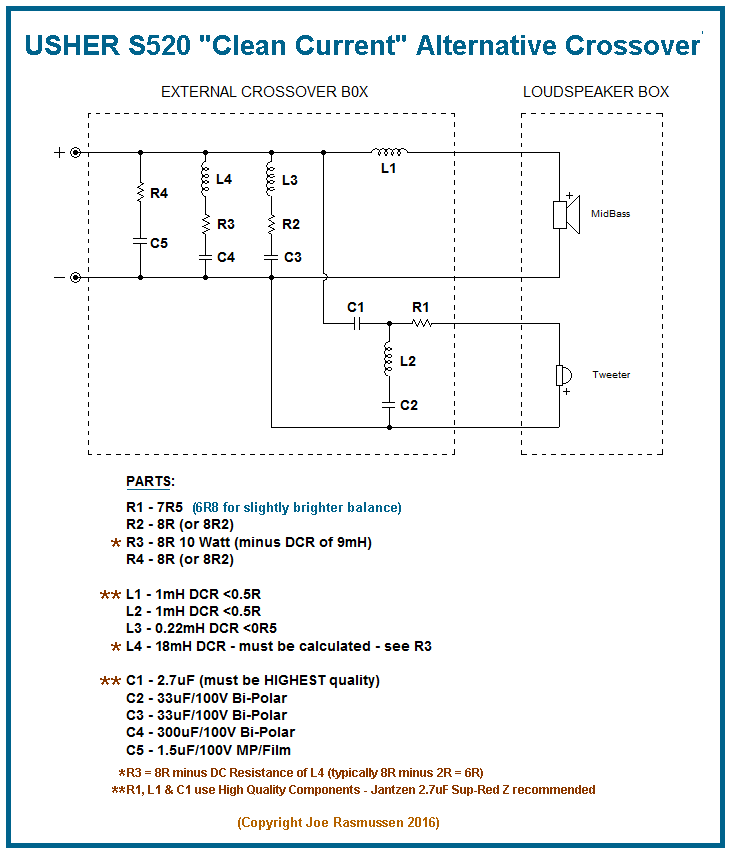
Driven by a "Perfect" voltage amp, which presents a short circuit output impedance to the speaker, the speaker cannot even "see" the correction network. All it sees is a short.
It's the Amp that sees the correction network. And it works better. Geddit? 😎
Does the amp work better? What you are suggesting is the trading off a reactive impedance load with higher efficiency against a lower resistive load with lower efficiency. It's 6 to 1/2 dozen which is better.
PS. Why are you referring to a series crossover speaker and posting one with a parallel network? And series or parallel has nothing to do with it anyway.
Last edited:
For people who don't know, my old mate John Kreskovsky is quite special. 😀
He's one of the audio pioneers who had loads of good ideas. Just for you, John, I present the reason why Series crossovers ARE special. I used to work with grim-sounding FM radio, and better sounding AM. You called it wrong, IMO. The slopes matter. But that's not to discount the fact that 90% of what you say is right.
I think you should just get back into enjoying this subject. A sort of rebirth. After all, nothing is perfect. All is compromise. 🙂
He's one of the audio pioneers who had loads of good ideas. Just for you, John, I present the reason why Series crossovers ARE special. I used to work with grim-sounding FM radio, and better sounding AM. You called it wrong, IMO. The slopes matter. But that's not to discount the fact that 90% of what you say is right.
I think you should just get back into enjoying this subject. A sort of rebirth. After all, nothing is perfect. All is compromise. 🙂
Attachments
If you are using active networks before the amplifier it looks like most of the arguments about series parallel circuitry becomes a non issue. So in the case of a directly connect driver and amp what are the real advantages of using a current driven amplifier, that seems to be the real basis of this conversation. As soon as we add any impedance compensation or add a parallel component all bets are off on this subject it appears.
TBH, Joe has given us the output of his labours absolutely for free. .
This is a DIY site, lots of people do that every day here, but don't go 'help help I'm being repressed' when someone asks a leading question.
For people who don't know, my old mate John Kreskovsky is quite special. 😀
He's one of the audio pioneers who had loads of good ideas. Just for you, John, I present the reason why Series crossovers ARE special. I used to work with grim-sounding FM radio, and better sounding AM. You called it wrong, IMO. The slopes matter. But that's not to discount the fact that 90% of what you say is right.
I think you should just get back into enjoying this subject. A sort of rebirth. After all, nothing is perfect. All is compromise. 🙂
Nothing against series x-o's, when they work, but you posted a pict of Joe's crossover with that statement which isn't a series job. Notice you deleted the pict from you post, so...

- Status
- Not open for further replies.
- Home
- Loudspeakers
- Multi-Way
- Joe Rasmussen Usher S520 "Current Compatible" Crossover

